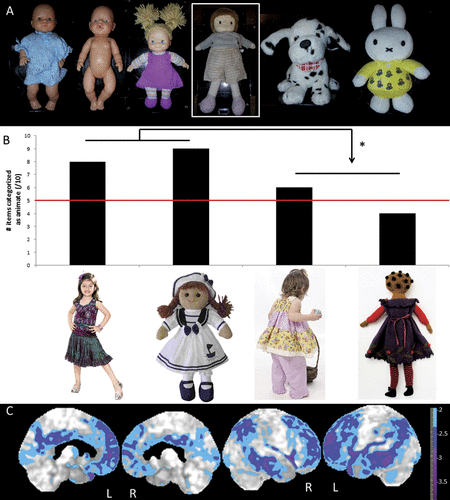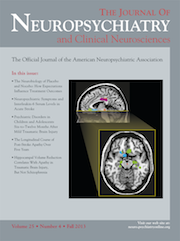Face-Selective Hyper-Animacy and Hyper-Familiarity Misperception in a Patient With Moderate Alzheimer’s Disease
To the Editor: “Ms. IS” was diagnosed with moderate Alzheimer’s disease (AD) and displayed a particular delusion: she was convinced that a toy doll was her living baby. Neuropsychological investigations showed that familiarity recognition was increased for unfamiliar faces, while normal for famous faces and both famous and unfamiliar buildings. IS recognized more pictures of humans and dolls as “living” when the face was visible, compared with when the face was not visible. FDG-PET showed severe prefrontal hypometabolism in addition to the associated AD pattern. The findings illustrate that face-selective hyper-animacy and hyper-familiarity processing constitute the neuropsychological deficits as originating factors in IS’s delusion.
Misidentification symptoms (MIS) are common in AD. Patient IS is an 80-year-old retired teacher referred to our geriatric psychiatry unit after showing memory deficits, aggression toward her husband, and a remarkable delusion: IS believed that a toy doll was her child and she carried it around, cared for it, talked to it, and caressed it.1 She claimed it could walk and talk. Her cognitive and behavioral symptoms emerged about a year before her admission, whereas the delusion originated 6 months later, after the birth of a grandchild.
The Mini-Mental State Exam revealed a score of 16/30, with deficits in temporal (0/5) and topographical (2/5) orientation and memory (0/3). She scored normal on attention and visuo-construction. Magnetic Resonance Imaging (MRI) revealed cortico-subcortical atrophy. A diagnosis of moderate probable AD was withheld.
We presented famous and non-famous face pictures and asked IS whether they looked familiar. Subsequently, we presented the famous faces with three famous names printed underneath and asked IS to match picture and name.2 Compared with an elderly control group, IS performed at normal level for familiarity categorization of famous faces (p: NS), but deviant for unfamiliar faces (p <0.001). Picture-name matching was impaired (p <0.001).3 We also presented pictures of 12 famous and 11 non-famous buildings. IS performed normal for familiarity categorization of both famous and non-famous buildings (p: NS). Building name matching was impaired (p=0.023).
We presented IS with different toys one by one and asked her if they looked familiar and whether she could identify the exemplar (see Figure 1[A]). IS immediately interacted with every toy as if it were alive. For all toys, IS claimed she had seen them before, although she could not identify any. The only exception was a doll of which the face contained only the eyes, but no nose or mouth; IS indicated that she had not seen it before.

[A]: The toys that were sequentially presented to Ms. IS (from left to right). She recognized all toys as living and familiar, except the one in the white rectangle. [B, top]: results of animacy categorization experiment showing the number of categorizations as a function of category (human and doll) and viewpoint (front and back). The red bar indicates chance level (*p=0.013). [B, bottom]: examples of stimuli presented to the patient with the instruction to categorize as living or non-living (from left to right: front view of human; front view of toy doll; back view of human; back view of toy doll). [B, right]: results of the animacy categorization experiment. [C]: stereotactic surface projections showing medial (left) and lateral (right) views of the left (L) and right (R) hemisphere of an [18F]Fluorodeoxyglucose Positron Emission Tomography (FDG PET) brain scan of the patient, with areas of significant hypometabolism superimposed. Color coding refers to Z-scores with respect to normal dataset of 30 control subjects.
We presented IS also with 20 images of dolls and 20 images of humans. Half of each category were back views and half were front views. We asked IS whether the pictures showed a living human or a non-living doll. IS categorized 8/10 front views of humans and 9/10 front views of dolls as animate, whereas categorization of back views of humans (6/10) and dolls (4/10) were at chance level (Figure 1[B]). This constitutes a significantly larger animacy recognition for front views (p=0.013), but no significant difference between the number of human and doll front view pictures (p: NS).
Functional imaging by means of [18F] Fluorodeoxyglucose Positron Emission Tomography (FDG-PET) showed bilateral hypometabolism in the temporo-parietal cortex, including the precuneus, as well as extensive bilateral prefrontal hypometabolism (see Figure 1[C]).
The object perception abilities of IS show a face-specific hyper-familiarity processing in combination with a face-specific hyper-animacy processing. These neuropsychological deficits may constitute the originating factors in her delusion.4 The imaging data are compatible with a pattern of moderate AD, but additionally display medial and lateral prefrontal hypo-metabolism, possibly relating to the misattribution of mental states to inanimate objects5 and impaired belief evaluation,4 respectively.
1 : The emergence of delusional companions in Alzheimer’s disease: an unusual misidentification syndrome. Cogn Neuropsychiatry 2002; 7:317–328Crossref, Medline, Google Scholar
2 : A strange face in the mirror: face-selective self-misidentification in a patient with right lateralized occipito-temporal hypo-metabolism. Cortex 2012; 48:1088–1090Crossref, Medline, Google Scholar
3 : Comparing an individual's test score against norms derived from small samples. Clin Neuropsychol 1998; 12:482–486Crossref, Google Scholar
4 : Delusional belief. Annu Rev Psychol 2011; 62:271–298Crossref, Medline, Google Scholar
5 : Meeting of minds: the medial frontal cortex and social cognition. Nat Rev Neurosci 2006; 7:268–277Crossref, Medline, Google Scholar



